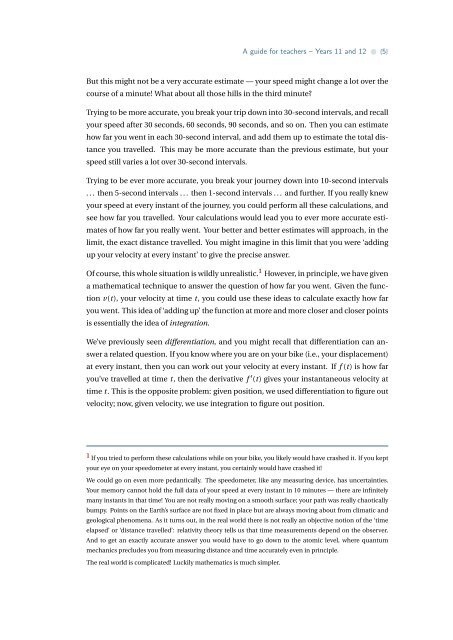Integration - the Australian Mathematical Sciences Institute
Integration - the Australian Mathematical Sciences Institute
Integration - the Australian Mathematical Sciences Institute
Create successful ePaper yourself
Turn your PDF publications into a flip-book with our unique Google optimized e-Paper software.
A guide for teachers – Years 11 and 12 • {5}But this might not be a very accurate estimate — your speed might change a lot over <strong>the</strong>course of a minute! What about all those hills in <strong>the</strong> third minute?Trying to be more accurate, you break your trip down into 30-second intervals, and recallyour speed after 30 seconds, 60 seconds, 90 seconds, and so on. Then you can estimatehow far you went in each 30-second interval, and add <strong>the</strong>m up to estimate <strong>the</strong> total distanceyou travelled. This may be more accurate than <strong>the</strong> previous estimate, but yourspeed still varies a lot over 30-second intervals.Trying to be ever more accurate, you break your journey down into 10-second intervals. . . <strong>the</strong>n 5-second intervals . . . <strong>the</strong>n 1-second intervals . . . and fur<strong>the</strong>r. If you really knewyour speed at every instant of <strong>the</strong> journey, you could perform all <strong>the</strong>se calculations, andsee how far you travelled. Your calculations would lead you to ever more accurate estimatesof how far you really went. Your better and better estimates will approach, in <strong>the</strong>limit, <strong>the</strong> exact distance travelled. You might imagine in this limit that you were ‘addingup your velocity at every instant’ to give <strong>the</strong> precise answer.Of course, this whole situation is wildly unrealistic. 1 However, in principle, we have givena ma<strong>the</strong>matical technique to answer <strong>the</strong> question of how far you went. Given <strong>the</strong> functionv(t), your velocity at time t, you could use <strong>the</strong>se ideas to calculate exactly how faryou went. This idea of ‘adding up’ <strong>the</strong> function at more and more closer and closer pointsis essentially <strong>the</strong> idea of integration.We’ve previously seen differentiation, and you might recall that differentiation can answera related question. If you know where you are on your bike (i.e., your displacement)at every instant, <strong>the</strong>n you can work out your velocity at every instant. If f (t) is how faryou’ve travelled at time t, <strong>the</strong>n <strong>the</strong> derivative f ′ (t) gives your instantaneous velocity attime t. This is <strong>the</strong> opposite problem: given position, we used differentiation to figure outvelocity; now, given velocity, we use integration to figure out position.1 If you tried to perform <strong>the</strong>se calculations while on your bike, you likely would have crashed it. If you keptyour eye on your speedometer at every instant, you certainly would have crashed it!We could go on even more pedantically. The speedometer, like any measuring device, has uncertainties.Your memory cannot hold <strong>the</strong> full data of your speed at every instant in 10 minutes — <strong>the</strong>re are infinitelymany instants in that time! You are not really moving on a smooth surface; your path was really chaoticallybumpy. Points on <strong>the</strong> Earth’s surface are not fixed in place but are always moving about from climatic andgeological phenomena. As it turns out, in <strong>the</strong> real world <strong>the</strong>re is not really an objective notion of <strong>the</strong> ‘timeelapsed’ or ‘distance travelled’: relativity <strong>the</strong>ory tells us that time measurements depend on <strong>the</strong> observer.And to get an exactly accurate answer you would have to go down to <strong>the</strong> atomic level, where quantummechanics precludes you from measuring distance and time accurately even in principle.The real world is complicated! Luckily ma<strong>the</strong>matics is much simpler.
















